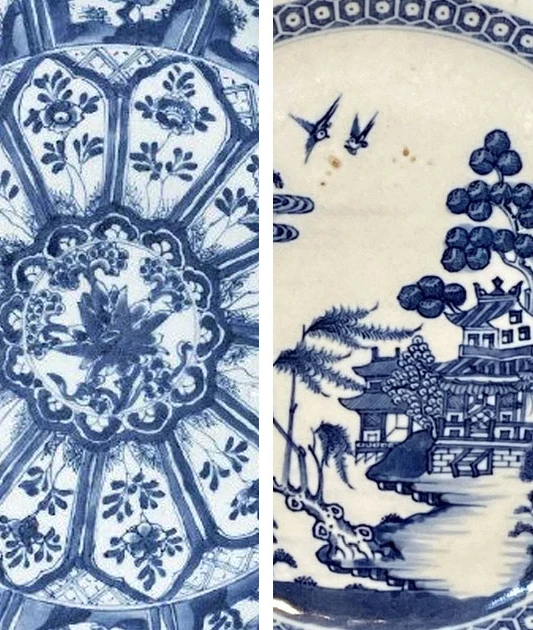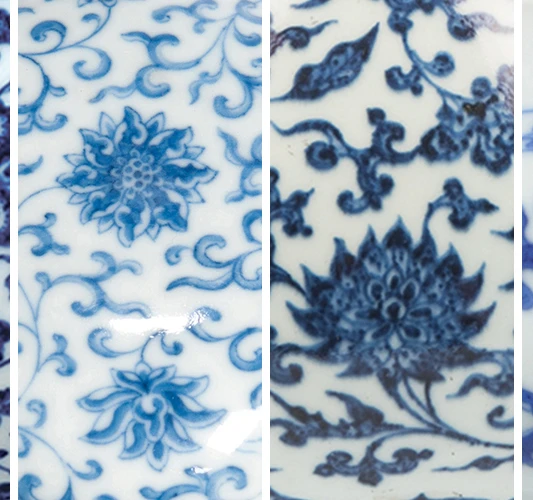Chinese Porcelain Patterns
Chinese porcelain patterns are among the most iconic and influential designs in the history of decorative arts.
1. Historical Background
Chinese porcelain has been produced since the Tang Dynasty (618–907 AD), but it reached its peak in the Ming (1368–1644) and Qing (1644–1912) dynasties. Porcelain was prized both domestically and as an export to the Middle East, Europe, and beyond.
2. Common Chinese Porcelain Patterns
Blue and White (Qinghua 青花)
-
Description: White porcelain painted with cobalt blue underglaze.
-
Time Period: Popular since the Yuan Dynasty (1279–1368) and especially prominent during the Ming Dynasty.
-
Motifs: Dragons, phoenixes, floral scrolls, landscapes, and narrative scenes.
Famille Rose (Fencai 粉彩)
-
Description: Soft pastel enamels, often pink, used over the glaze.
-
Time Period: Qing Dynasty, especially the 18th century.
-
Motifs: Peonies, birds, figures, and auspicious symbols.
Famille Verte (Wucai 五彩)
-
Description: "Five colors" including green, red, yellow, blue, and purple.
-
Time Period: Kangxi period (1661–1722) of the Qing Dynasty.
-
Motifs: Garden scenes, mythical creatures, and imperial themes.
Celadon
-
Description: Pale green glaze, sometimes carved or molded with patterns.
-
Time Period: Especially during the Song Dynasty (960–1279).
-
Motifs: Subtle floral or geometric designs.
Imari Style
-
Description: Originally Japanese, but adopted by Chinese porcelain makers for export.
-
Features: Overglaze red and gold atop underglaze blue.
3. Symbolism in Patterns
Symbol Meaning Dragon Imperial power, strength Phoenix Beauty, high virtue, often paired with the dragon Lotus Purity, enlightenment Peony Wealth, prosperity Crane Longevity Fish Abundance, good fortune Bats Happiness (a pun: "fu" means both "bat" and "blessing")4. Export Ware
During the Ming and Qing dynasties, Chinese porcelain was tailored to Western tastes, including armorial ware (bearing European family crests), Dutch Delft-inspired designs, and chinoiserie patterns.
Expanded Overview: Blue and White Chinese Porcelain
1. Origins and Historical Development
Yuan Dynasty (1279–1368)
-
Innovation: The earliest high-quality blue and white porcelain was produced in Jingdezhen, using imported cobalt from Persia.
-
Style: Bold brushwork and large motifs, often with Islamic artistic influences due to trade along the Silk Road.
-
Forms: Large vases, dishes, and jars used for both domestic use and export.
Ming Dynasty (1368–1644)
-
Golden Age: Blue and white reached a technical and artistic peak under emperors like Xuande (1425–1435) and Chenghua (1464–1487).
-
Refinement: Softer cobalt tones, finer lines, and complex, narrative scenes. Kilns became more regulated under imperial control.
-
Exports: Widely exported to the Middle East, Southeast Asia, and Europe.
Qing Dynasty (1644–1912)
-
Kangxi Period (1661–1722): Revival of blue and white with high technical sophistication; vibrant blue tones with clear glazes.
-
Yongzheng & Qianlong Periods (1722–1796): Delicate and elegant designs; integration with other techniques like overglaze enamels and famille rose.
-
Export Influence: Designs began to reflect European tastes (e.g., florals, rococo elements), leading to armorial and bespoke commissions.
2. Materials and Techniques
-
Porcelain Body: Made from kaolin and petuntse, fired at high temperatures (approx. 1300°C).
-
Cobalt Blue Pigment: Originally imported from Persia (Sumatra cobalt); later, Chinese sources were also used.
-
Underglaze Decoration: Designs painted on the raw porcelain body, then covered with a clear glaze and fired.
-
Kilns: Jingdezhen, known as the "Porcelain Capital," was the main production center for centuries.
3. Common Motifs and Symbolism
Motif Symbolism Dragon Imperial authority, power, strength Phoenix Peace, feminine virtue, often with dragon Lotus Flower Purity, Buddhism Peony Wealth, honor Clouds and Waves Celestial realm, cosmic order Crane Longevity, wisdom Fish (Carp) Abundance, perseverance, success Vines and Flowers Natural beauty, fertility Figural Scenes Often from folklore, literature, or court life4. Styles and Forms
-
"David Vases" Style: Yuan Dynasty examples with large floral scrolls and elephant-head handles.
-
"Ming Jar": Large storage vessels with high shoulders and dynamic imagery (e.g., dragons or figures).
-
"Kraak Ware": Export porcelain from the late Ming period, often with paneled decoration, made for Europe.
-
"Transitional Ware": Early Qing pieces with looser, more painterly brushwork during political transition.
5. Influence and Legacy
-
Islamic & European Markets: Designs adapted for Middle Eastern tastes (e.g., mosque lamp shapes) and European motifs (e.g., armorial ware).
-
Imitations: Widely copied in Japan (Arita ware), Persia, and later Europe (e.g., Delftware, Meissen).
-
Modern Value: Authentic Ming and Yuan blue and white porcelains are highly prized at auctions and by museums worldwide.

